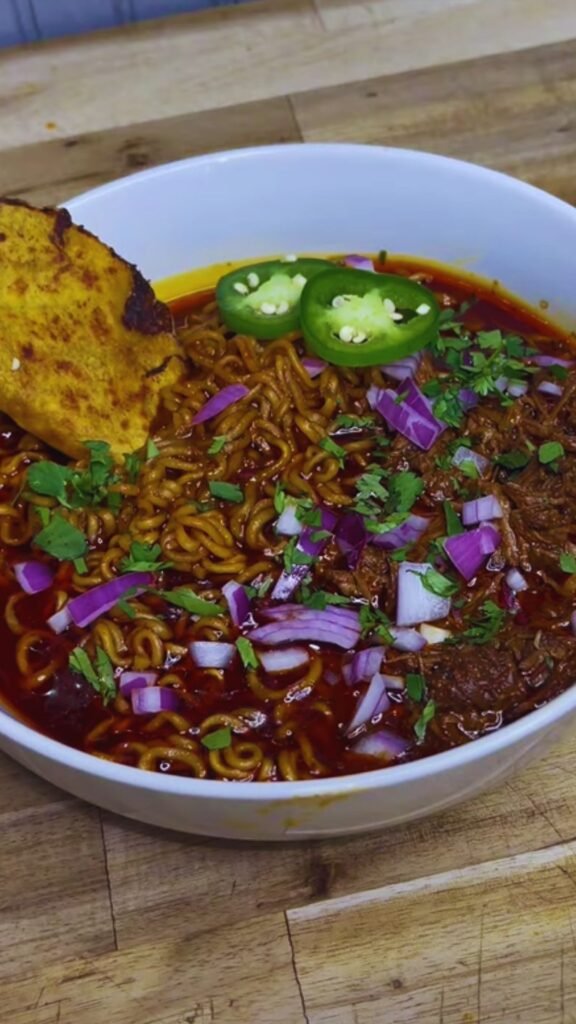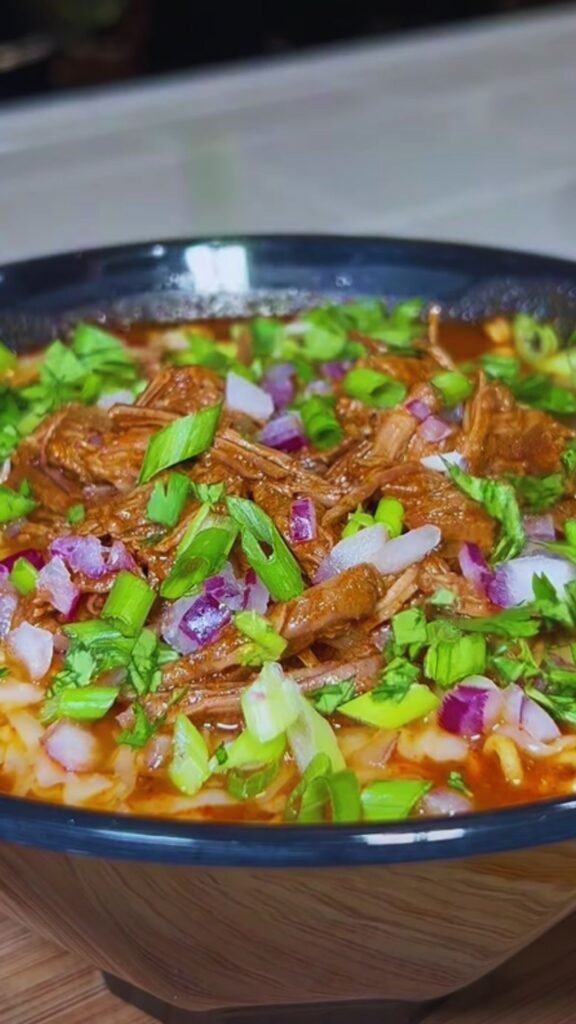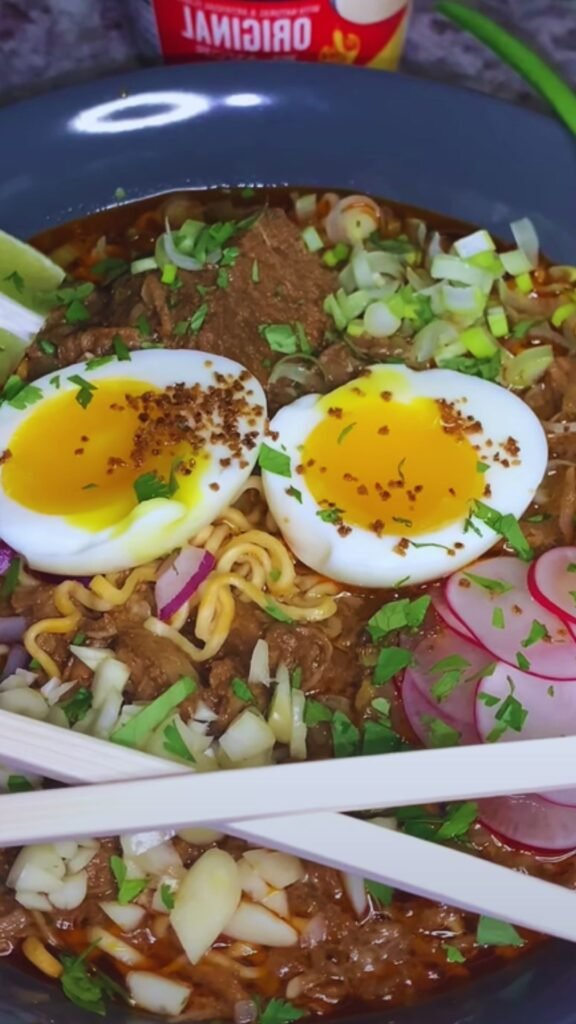Have you ever found yourself torn between craving the rich, spicy flavors of Mexican birria and the comforting warmth of Japanese ramen? Well, I’ve got amazing news for you – you don’t have to choose! Birria ramen represents the perfect marriage of these two beloved culinary traditions, creating a bowl of noodle soup that’s absolutely bursting with flavor.
When I first discovered birria ramen, I was admittedly skeptical. Could two distinct food cultures really blend so seamlessly? But after my first spoonful of that chile-infused broth with tender beef and bouncy noodles, I was completely converted. This fusion dish has quickly become my go-to recipe when I want to impress dinner guests or simply treat myself to something extraordinary.
In this comprehensive guide, I’ll walk you through everything you need to know about making restaurant-quality birria ramen at home. From selecting the perfect cuts of meat to creating that signature red consommé and assembling the final bowl, I’ve got you covered with step-by-step instructions, expert tips, and all the cultural context you could want.
What Is Birria Ramen?
Before diving into the recipe, let’s take a moment to understand what makes birria ramen so special. This fusion dish combines elements from two distinct culinary traditions:
Birria: Originally from Jalisco, Mexico, traditional birria is a spicy stew typically made with goat or beef that’s been slow-cooked with a blend of chiles and spices until meltingly tender. The meat is served with its cooking liquid (consommé), which has a distinctive red color and deeply complex flavor.
Ramen: This Japanese noodle soup consists of Chinese-style wheat noodles served in a meat or fish-based broth, often flavored with soy sauce or miso, and topped with ingredients like sliced pork, nori, and soft-boiled eggs.
Birria ramen cleverly takes the rich, chile-infused meat and consommé from birria and uses it as the base for a ramen bowl. Instead of serving the birria with tortillas, it’s paired with ramen noodles and traditional ramen toppings for a cross-cultural culinary experience that honors both traditions while creating something entirely new.
The History of Fusion
The beauty of birria ramen lies in its relatively recent origin story. Unlike many traditional dishes with centuries of history, birria ramen is a modern creation born from cultural exchange and culinary innovation.
The dish gained popularity around 2019-2020, particularly in cities with vibrant Mexican and Asian food scenes like Los Angeles and San Francisco. Social media platforms, especially TikTok and Instagram, helped catapult this fusion creation into mainstream awareness, with vibrant videos showcasing the dramatic red broth and cheese pulls making it instantly viral-worthy.
What makes this fusion particularly natural is that both culinary traditions place immense importance on broths developed through long, slow cooking processes to extract maximum flavor. Both also feature meat as a central protein component and involve a balance of spices and aromatics to create complex flavor profiles.
Essential Ingredients
To create authentic birria ramen at home, you’ll need ingredients from both Mexican and Japanese cooking traditions. Here’s what you’ll need:
For the Birria:
- 3 pounds beef (I recommend a mix of chuck roast, short ribs, and beef shank for optimal flavor and texture)
- 6 dried guajillo chiles
- 3 dried ancho chiles
- 2 dried chipotle chiles (optional, for smokiness and heat)
- 1 white onion, quartered
- 8 garlic cloves
- 1 cinnamon stick
- 2 bay leaves
- 1 tablespoon dried oregano (preferably Mexican)
- 1 teaspoon dried thyme
- 1 teaspoon cumin seeds
- 1 teaspoon black peppercorns
- 3 whole cloves
- 2 tablespoons apple cider vinegar
- 2 tablespoons tomato paste
- 8 cups beef broth
- Salt to taste
For the Ramen Assembly:
- 4 packages (approximately 14-16 oz total) fresh ramen noodles (or high-quality dried noodles)
- 4 soft-boiled eggs, halved
- 1 cup corn kernels (fresh or frozen)
- 2 cups thinly sliced cabbage
- 1 cup thinly sliced radishes
- 1/2 cup chopped cilantro
- 2 limes, cut into wedges
- 2 avocados, sliced
- 1 cup crumbled queso fresco or Cotija cheese
- 4 scallions, thinly sliced
- Sliced jalapeños (optional, for extra heat)
Equipment You’ll Need

Before starting, make sure you have these essential tools on hand:
- Large Dutch oven or heavy-bottomed pot
- Blender or food processor
- Fine mesh strainer
- Large soup bowls for serving
- Tongs for handling the meat and noodles
- Sharp knife for slicing ingredients
- Large pot for cooking noodles
- Cutting board
- Measuring cups and spoons
Detailed Step-by-Step Instructions
Phase 1: Preparing the Chile Paste
- Remove stems and seeds from all dried chiles.
- Heat a dry skillet over medium heat and lightly toast the chiles for 1-2 minutes per side, being careful not to burn them (burned chiles will make your broth bitter).
- Place the toasted chiles in a bowl and cover with hot water. Allow to soak for about 30 minutes until soft and pliable.
- While the chiles are soaking, toast your whole spices (cumin seeds, peppercorns, cloves) in the same dry skillet until fragrant, about 1-2 minutes.
- Drain the softened chiles, reserving 1 cup of the soaking liquid.
- In a blender, combine the softened chiles, 1/2 of the quartered onion, 4 garlic cloves, toasted spices, apple cider vinegar, tomato paste, and 1 cup of the reserved chile soaking liquid.
- Blend until completely smooth, adding a little more soaking liquid if needed to achieve a smooth consistency.
- Pass the mixture through a fine-mesh strainer to remove any remaining solids or skins, pushing with a spatula to extract all the flavorful paste.
Phase 2: Cooking the Birria
- Cut the beef into large chunks (about 2-3 inches). Season generously with salt.
- Heat 2 tablespoons of oil in your Dutch oven over medium-high heat.
- Working in batches to avoid overcrowding, sear the beef on all sides until deeply browned (about 3-4 minutes per side). Transfer the seared meat to a plate.
- In the same pot, add the remaining onion quarters and garlic cloves. Sauté until lightly caramelized, about 3-4 minutes.
- Pour in 1 cup of beef broth to deglaze the pot, scraping up all the flavorful browned bits from the bottom.
- Return the seared meat to the pot.
- Add the strained chile paste, cinnamon stick, bay leaves, oregano, and thyme.
- Pour in the remaining beef broth. The liquid should just cover the meat; add a little water if needed.
- Bring to a boil, then reduce heat to low. Cover and simmer for 3-4 hours, or until the meat is fall-apart tender when pierced with a fork.
- Once the meat is cooked, remove it from the broth and set aside to cool slightly.
- Strain the cooking liquid through a fine-mesh strainer into a clean pot to create your consommé.
- When the meat is cool enough to handle, shred it using two forks, discarding any large pieces of fat or gristle.
- Return about 1/3 of the shredded meat to the consommé to flavor it further, reserving the rest for topping your ramen bowls.
Phase 3: Assembling Your Birria Ramen
- Cook the ramen noodles according to package instructions, being careful not to overcook. They should be al dente as they will continue cooking slightly in the hot broth.
- Drain the noodles and divide them among 4 large, deep bowls.
- Ladle the hot consommé (with the meat that’s been returned to it) over the noodles, filling each bowl about 2/3 full.
- Arrange portions of the remaining shredded birria meat on top of each bowl.
- Add your toppings: half a soft-boiled egg, corn, sliced cabbage, radishes, cilantro, a lime wedge, avocado slices, crumbled cheese, and sliced scallions.
- Serve immediately, allowing each person to squeeze lime juice over their bowl and mix the ingredients as desired.
Temperature and Timing Chart
For perfect results, follow these temperature and timing guidelines:
| Component | Temperature | Timing | Visual Cue |
|---|---|---|---|
| Toasting Chiles | Medium heat | 1-2 minutes per side | Slightly darkened but not blackened |
| Searing Beef | Medium-high heat | 3-4 minutes per side | Deep brown crust formed |
| Simmering Birria | Low heat (barely bubbling) | 3-4 hours | Meat easily falls apart when prodded |
| Soft-boiled Eggs | Boiling water, then covered off heat | 6 minutes 30 seconds | Whites set, yolks jammy |
| Ramen Noodles | Rolling boil | Follow package (typically 2-3 minutes) | Al dente with slight resistance |
Nutritional Information
Here’s the approximate nutritional breakdown per serving of birria ramen (based on 4 servings):
| Nutrient | Amount per Serving |
|---|---|
| Calories | 820 |
| Protein | 58g |
| Fat | 42g |
| Carbohydrates | 54g |
| Fiber | 8g |
| Sodium | 1250mg |
| Sugar | 6g |
| Cholesterol | 215mg |
Pro Tips For The Perfect Birria Ramen

Having made this dish countless times, I’ve picked up some tricks that make a significant difference:
- Low and slow is key: Don’t rush the birria cooking process. The magic happens with long, slow cooking to break down the tough cuts of meat and develop that rich flavor.
- Balance your meat cuts: Using a combination of fatty and lean cuts creates the perfect balance. Chuck roast provides the base, short ribs add richness, and beef shank contributes gelatin for a silky mouthfeel.
- Skim the fat – but not all of it: As your birria simmers, occasionally skim excess fat from the surface, but leave some behind. That red-tinged fat carries tremendous flavor and gives the consommé its characteristic richness.
- Season in layers: Season the meat before searing, then taste and adjust the final consommé before serving. Remember that the reduction during long cooking will intensify saltiness.
- Prepare components ahead: The birria component actually improves with time and can be made 1-2 days in advance, making this a great option for entertaining.
- Don’t overcook the noodles: Slightly undercook your ramen noodles as they’ll continue to cook in the hot broth.
- Serve in pre-warmed bowls: Cold bowls will quickly cool your ramen. Warm them by filling with hot water for a minute before emptying and adding your components.
Common Mistakes to Avoid
Even experienced cooks can run into trouble with this complex dish. Here are pitfalls to watch for:
- Burning the chiles: This will make your entire dish bitter with no remedy. Toast them just until fragrant, watching carefully.
- Skipping the searing step: Properly browning the meat creates depth of flavor through the Maillard reaction. Don’t rush or skip this critical step.
- Cooking at too high a temperature: Birria needs a gentle simmer, not a rolling boil, which can toughen the meat.
- Over-straining the consommé: While you want a clear broth, over-straining can remove too much of the flavorful chile solids. A single pass through a regular mesh strainer is sufficient.
- Overcrowding toppings: While it’s tempting to pile on every possible garnish, too many toppings can dilute the star of the show – that amazing birria consommé.
Variations to Try

Once you’ve mastered the basic recipe, consider these exciting variations:
Protein Alternatives:
- Goat Birria Ramen: Using traditional goat meat for an authentic Jalisco-style birria base
- Lamb Birria Ramen: Substitute lamb shoulder for a slightly gamier flavor profile
- Pork Birria Ramen: Pork shoulder works beautifully with the chile flavors
- Vegetarian Birria Ramen: Use mushrooms (particularly oyster and king oyster) and jackfruit for a meat-free alternative
Regional Variations:
- Tijuana-Style: Add adobo sauce to the chile blend for extra complexity
- Tonkotsu Fusion: Create a hybrid broth using pork bones simmered overnight combined with the chile paste
- Miso Birria Ramen: Incorporate red miso paste into your consommé for an umami boost
Topping Twists:
- Quesabirria Ramen: Add a generous amount of melted Oaxaca cheese to create cheese pulls
- Birria Mazemen: Use less broth for a “dipping ramen” style similar to tsukemen
- Spicy Birria Ramen: Add extra chiles de árbol or habaneros to the chile paste for heat lovers
Serving Suggestions
Birria ramen makes for a complete meal on its own, but if you’re planning a more elaborate spread, consider these complementary dishes:
- Appetizers:
- Tostadas with guacamole
- Gyoza with a chile dipping sauce
- Small quesadillas made with the extra birria meat
- Side Dishes:
- Simple cucumber salad with lime and Tajín
- Japanese-style pickled vegetables
- Mexican rice with cilantro
- Beverages:
- Horchata
- Tamarind agua fresca
- Mexican hibiscus tea (Jamaica)
- Sparkling water with lime
- Desserts:
- Mochi ice cream
- Churros with chocolate sauce
- Matcha panna cotta with cajeta drizzle
Storage and Reheating Tips
If you have leftovers (although this is rarely the case in my home!), here’s how to store and reheat them properly:
- Consommé: Store in an airtight container in the refrigerator for up to 4 days. The fat will solidify on top, which actually helps preserve it. You can either remove this fat cap before reheating or stir it back in for added richness.
- Shredded Meat: Keep separate from the broth in an airtight container for up to 4 days in the refrigerator.
- Assembled Ramen: I don’t recommend storing fully assembled bowls as the noodles will become soggy. Instead, store components separately.
- Freezing: The consommé and meat freeze exceptionally well for up to 3 months. Thaw overnight in the refrigerator before reheating.
- Reheating Consommé: Warm gently on the stovetop until just simmering.
- Reheating Meat: Add to warm consommé, or for crispy edges, briefly pan-fry before adding to your ramen bowl.
- Fresh Components: Always prepare fresh noodles and garnishes when serving leftover birria components.
Frequently Asked Questions
Can I make birria ramen in a slow cooker or pressure cooker? Absolutely! For slow cookers, follow the recipe through searing the meat and making the chile paste, then transfer everything to the slow cooker and cook on low for 8 hours. For pressure cookers or Instant Pots, cook at high pressure for 45 minutes with a 15-minute natural release. The flavor won’t be quite as developed as the stovetop method, but it’s still delicious.
Where can I find dried Mexican chiles if they’re not available locally? Many online retailers specialize in Mexican ingredients. Look for reputable sources like MexGrocer, Rancho Gordo, or even Amazon. In a pinch, you can substitute ancho chiles with a combination of paprika and a little cayenne, though the flavor profile won’t be identical.
What’s the best type of noodle to use for birria ramen? Fresh ramen noodles are ideal, but good-quality dried ramen works too. Look for noodles without seasoning packets since you’ll be using your birria consommé. In a pinch, you can substitute with fresh or dried Chinese egg noodles or even linguine.
Is birria ramen always spicy? The level of spice is entirely customizable. Using primarily ancho and guajillo chiles creates a deeply flavorful but mild to medium heat level. For extra spiciness, add arbol chiles to your chile paste or serve with sliced fresh jalapeños or habaneros on the side.
Can I prepare any components ahead of time for easier serving? Yes! The birria meat and consommé actually improve with 1-2 days of refrigeration as the flavors meld. Prepare these components ahead, and then just cook fresh noodles and prepare garnishes when ready to serve.
What can I do with leftover birria meat if I make too much? Leftover birria meat is incredibly versatile! Use it in tacos, quesadillas, burritos, nachos, or even as a topping for fried rice. It also freezes beautifully for future ramen bowls.
Can I make a vegetarian version of birria ramen? Yes! Replace the beef with a combination of mushrooms (particularly king oyster and oyster varieties), jackfruit, and extra-firm toasted with excellent results. Use mushroom or vegetable broth instead of beef broth, and consider adding a bit of soy sauce or miso for umami depth.
Why does my consommé have a layer of red oil on top? That’s the birria fat that’s been infused with the chile color – it’s liquid gold! You can skim some off if there’s excessive fat, but leaving some will give your ramen that authentic richness that makes birria ramen special.
The Cultural Significance
What makes birria ramen so fascinating is not just its incredible flavor, but what it represents culturally. This dish exemplifies how globalization and cultural exchange can create something greater than the sum of its parts.
Mexico and Japan have a surprisingly long history of cultural exchange, dating back to the early 17th century. In modern times, cities with diverse populations have become incubators for fusion cuisine that respects the integrity of both culinary traditions while creating something new and exciting.
Birria ramen doesn’t dilute either tradition – rather, it highlights the best aspects of both. The chilies and slow-cooked meat technique of Mexican cuisine complement the noodle soup format and careful presentation of Japanese ramen. The result is a dish that feels both innovative and somehow familiar.
When you serve birria ramen, you’re not just enjoying a delicious meal; you’re participating in a living example of cultural appreciation and creativity. Food has always been one of humanity’s most powerful ways to bridge differences and find common ground – a truth deliciously demonstrated in every steaming bowl of birria ramen.
So gather your ingredients, take your time with the process, and enjoy not just the incredible flavors but the story behind this remarkable fusion dish. Your taste buds – and your dinner guests – will thank you!


